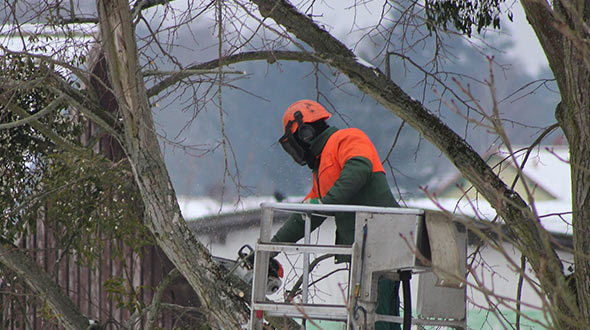
Avoid your trees falling or dying from a disease that can often be treated. Knowing how to identify and treat tree diseases will prevent avoidable death, and help you encourage healthy, robust tree growth.
toddsmariettatreeservices.com gathered information on identification and treatment of anthracnose, canker diseases, and Dutch elm disease, all of which attack, weaken, and kill trees.
3 Tree Diseases
The following three tree diseases can be tricky to treat. However, once you identify a disease and know how it affects your tree, you can take immediate action to treat it. The following are three common diseases found on trees in the US and around the world:
Anthracnose Tree Disease

Anthracnose is a common fungal disease infecting shade trees. The disease causes the following symptoms:
- Bud death
- Twig death
- Leaf cupping/curling
- Dead, irregular spots on leaves
- Dead tissue along leaf veins
- Dead blotches between leaf veins
- Unseasonal or premature leaf-drop
Treat an anthracnose disease infection by:
Avoiding Spraying Tree Foliage – Anthracnose fungi depend on splashing water and wind to carry them from one host to another. If you try to wash the disease off the foliage, you contribute to the fungi’s perpetuation.
Collecting and destroying fallen leaves – Dead leaves (when left on the ground) provide an optimal location for fungi to lie dormant.

Pruning – The fungi and acervuli (fruiting structures) found in blighted twigs should be pruned back and destroyed. Crown thinning allows more air and light to reach inner branches and foliage; this helps fight against the fungi.
Note: In extreme cases of infection, excessive pruning may be required. When this is the case, contact a professional tree service to evaluate the situation.
Tip: Destroy pruned portions of the tree and its leaves in a fire pit or have a bonfire.
Tree Canker Diseases

Cankers are localized areas of bark and cambium necrosis (dead spots commonly exhibiting an open wound) on stems, twigs, branches, and/or the trunk caused by bacteria or fungi. Canker disease causes trees to display the following symptoms:
- Leaf chlorosis
- Reduced twig and smaller leaf growth
- Dead leaves remain attached to the tree
- Dead branches or limbs (dieback)
- Water sprouts growing from the trunk, large limbs, or roots
- White, decayed sapwood in the tree’s cankered areas
- Outer bark sloughing off of branches and/or trunk
Treat cankers on limbs and branches as follows:
- Carefully prune affected limbs and branches from the tree.
- Wood infected by any bacteria or fungi should be handled cautiously.
- Do not run these limbs and branches through a wood chipper.
- This wood can and should be burned.

Treat cankers on tree trunks as follows:
When cankers reach the tree trunk, there is little to nothing you can do to prevent the tree’s eventual decline and death. However, if your tree was healthy and robust when the infection occurred, it is possible that the tree compartmentalized (isolated) the infected wood on its own.
Note: Hire a professional tree service to carefully evaluate and determine a course of action for your tree.
Dutch Elm Disease

Dutch elm disease (DED), caused by a fungal pathogen (Ophiostoma novo-ulmi or Ophiostoma ulmi), is responsible for the decimation of native American elm species. This disease is most often vectored by European (Scolytus multistriatus) and North American (Hylurgopinus rufipes), and banded elm (S. schevyrewi) elm bark beetles. However, the disease may pass from tree to tree via root grafts with infected trees. Symptoms typically include:
- Leaves on one or more branches in the outer crown turn yellow, wilt, and eventually turn brown.
- Fallen leaves are noticeable in spring or summer.
- Symptoms often appear in late spring and/or early summer but may occur at any time during the tree’s growing season.
- Leaf yellowing and wilting continues down infected branches toward the tree trunk.
- How fast the signs spread down the tree depends on the tree species’ health and susceptibility. Infected trees may die in a single growing season or over multiple years.
- Brown streaking can be seen on the sapwood of wilted branches when the bark is stripped away.
- Confirm a DED infection by sending a sample of branches with leaves displaying symptoms to your University’s local extension for analysis.
Dutch elm disease can be treated when caught in very early stages by:
- Reducing the number of beetle breeding sites by promptly removing dead or dying trees.
- Immediately pruning away DED infected branches.
- Immediately removing trees with many DED infected branches.
- Burying, debarking, burning, or chipping wood from DED infected elm trees.
- Severing root grafts between neighboring elms before the infected tree is removed to prevent infection.

Tip: When considering injectable fungicides to prevent DED, hire a certified arborist to apply the injections.
Note: This disease affects native American elm species, like American (Ulmus americana), slippery (red) (Ulmus rubra), rock (Ulmus thomasii), September (Ulmus serotina), and cedar (Ulmus crassifolia) elms.
Treating Tree Diseases
In this article, you discovered essential information on how to identify and treat anthracnose, canker diseases, and Dutch elm disease before they weaken and kill your trees.
Taking swift action to help your tree and prevent its death will help you save thousands in potential physical and property damages.
Your failure to recognize a tree disease in its beginning phases can result in the swift death of your tree and infection of other surrounding trees.
Sources:
uaex.edu/environment-nature/forestry/health/disease-problems.aspx
ohioline.osu.edu/factsheet/plpath-tree-04
extension.umn.edu/plant-diseases/anthracnose-trees-and-shrubs
s3.wp.wsu.edu/uploads/sites/687/2015/06/MG-Canker-and-Wilt-Diseases-3.27.15-01.pdf
(678) 505-0266
Originally published on: http://www.toddsmariettatreeservices.com/tree-disease-treatment/

No comments:
Post a Comment